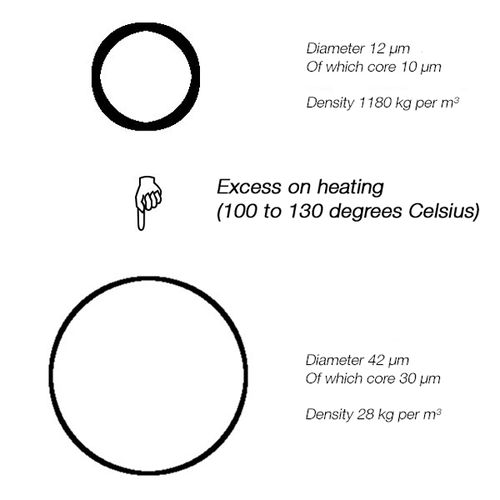Difference between revisions of "Micro hollow balls"
| Line 4: | Line 4: | ||
| − | + | Micro hollow balls or micro capsules are micro-encapsulations with a solid shell in which gaseous, liquid or solid substances are present. The purpose of the encapsulation is to release the contents under certain conditions (pressure, heat, etc.) or with time. The encapsulation can also expand with heat and thereby have a filling effect. | |
| − | Leather often has skin | + | [[Leather]] often has [[Natural markings on leather|skin damages]] which reduces the [[leather quality|quality]]. In the [[tannery]], such damages are partially repaired. One method is based on the thermally expandable microcapsules. For this purpose, a polymer dispersion, which is filled with liquefied gas, is applied. The microcapsules expand with the help of hot steam (about 3 seconds) by a multiple and form a compact composite with the leather fibre. The leather is thereby heated to about 100 ° C. Alternatively, the leather is also heated during the [[Embossed leather|embossing procedure]]. In a continuous-flow embossing machine, the leather is heated to 110 ° C. and the contact pressure is approx. 120 bar at a flow speed of 7 m / min. The repair process is simple, [[Haptic evaluation of leather surfaces|haptically]] appealing and does not increase the density of the leather. |
| + | Expanding micro hollow balls are also used in the production of cardboard and paper (reduced stiffness), of non-woven materials (more volume, but lighter), of sports shoe soles (lighter and more elastic) or at fillers for vehicle and boat surfaces (lighter, better sanding). | ||
| − | + | The micro hollow balls are increased by the heating to approximately 3.5 times the diameter and 50 to 100 times the volume. The density of the base material thereby decreases by 50 to 100 times. | |
| − | |||
| − | + | In the past, micro-hollow balls with an integrated [[Leather smell|odorant]] were offered for leather. These should burst through mechanical stress and develop a smell. Until today, this method has not been significantly advocated. | |
| − | + | ||
| − | + | ||
| − | + | ||
| Line 23: | Line 20: | ||
</p> | </p> | ||
<p align=center> | <p align=center> | ||
| − | '' | + | ''Micro hollow balls change their diameter and density when expanded by heat. The figures are exemplary values.''<br></p> |
<p> </p> | <p> </p> | ||
Revision as of 16:47, 4 February 2017
Micro hollow balls or micro capsules are micro-encapsulations with a solid shell in which gaseous, liquid or solid substances are present. The purpose of the encapsulation is to release the contents under certain conditions (pressure, heat, etc.) or with time. The encapsulation can also expand with heat and thereby have a filling effect.
Leather often has skin damages which reduces the quality. In the tannery, such damages are partially repaired. One method is based on the thermally expandable microcapsules. For this purpose, a polymer dispersion, which is filled with liquefied gas, is applied. The microcapsules expand with the help of hot steam (about 3 seconds) by a multiple and form a compact composite with the leather fibre. The leather is thereby heated to about 100 ° C. Alternatively, the leather is also heated during the embossing procedure. In a continuous-flow embossing machine, the leather is heated to 110 ° C. and the contact pressure is approx. 120 bar at a flow speed of 7 m / min. The repair process is simple, haptically appealing and does not increase the density of the leather.
Expanding micro hollow balls are also used in the production of cardboard and paper (reduced stiffness), of non-woven materials (more volume, but lighter), of sports shoe soles (lighter and more elastic) or at fillers for vehicle and boat surfaces (lighter, better sanding).
The micro hollow balls are increased by the heating to approximately 3.5 times the diameter and 50 to 100 times the volume. The density of the base material thereby decreases by 50 to 100 times.
In the past, micro-hollow balls with an integrated odorant were offered for leather. These should burst through mechanical stress and develop a smell. Until today, this method has not been significantly advocated.
Micro hollow balls change their diameter and density when expanded by heat. The figures are exemplary values.
Additional information









 a kotori web solution
a kotori web solution